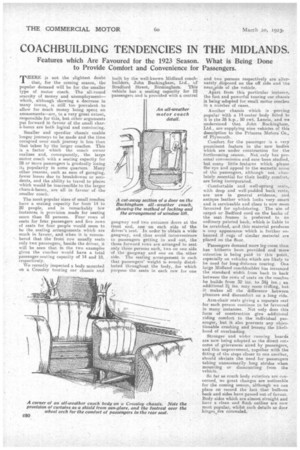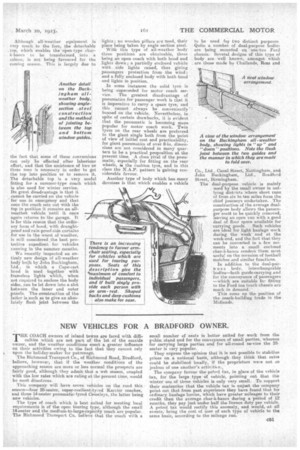COACHBUILDING TENDENCIES IN THE MIDLANDS.
Page 42

Page 43

If you've noticed an error in this article please click here to report it so we can fix it.
Features which Are Favoured for the 1923 Season. What is Being Done to Provide Comfort and Convenience for Passengers.
THERE is not the slightest doubt I that, for the coming season, the popular demand will be for the smaller type of motor coach. The all-round scarcity of money and unemployment— which, although showing a decrease in many towns, is Still too prevalent to allow for much money being spent on amusements—are, to a very great extent, responsible for this, but other arguments put forward in favour of the small chara-bancs are both logical and convincing:
Smaller and speedier chassis enable longer journeys to be made and the time occupied over each journey is less than that taken by the larger coaches. This is a factor which the coach owner realizes and, consequently, the large motor, coach with a seating capacity for 28 or more passengers is gradually losing its popularity in some quarters. Many other reasons, such as ease of garaging, fewer losses due to breakdowns or accidents, and the ability to travel to places which would be inaccessible to the larger chars-a-bancs, . are all in favour of the smaller coach.
The most popular sizes of small coaches have a seating capacity for from 14 to 20 people, and in remarkably few instances is provision made for seating more than 25 persons. Four rows of seats for four passengers and five rows of seats for four people would seem to he the seating arrangements which are much in favour, and when it. is remembered that the front row usually seats only two passengers, beside the driver, it will be seen that in the two examples given the coaches wonld have a total passenger-seating capacity of 14 and 18, respectively.
We recently inspected a body mounted on a Crossley touring car chassis and built by the well-known Midland coachbuilders, John Buckingham, Ltd., of Bradford Street, Birmingham. This vehicle has a seating capacity for 12 passengers and is provided with a central
gangway and two entrance doors at the front end, one on each side of the driver's seat.. In order to obtain a wide gangway, and thus avoid inconvenience to passengers getting in and out, the three forward rows are arranged to seat only three persons each, two on one side of the gangway and one on the other side. The seating arrangement is such that. passengers' weight is evenly distributed throughout the body, for which purpose the seats in each row for one and two persons respectively a-re alternately disposed on the off side and the nearaside of the vehicle.
Apart from this particular instance, the fast and powerful touring car chassis is being adopted for, small motor coaches in a number of cases.
Another chassis which is proving popular with a 14-seater body fitted to it is the 35 h.p., 50 cwt. Lancia, and we understand that John Buckingham, Ltd., are supplying nine vehicles of this description to the Princess Motors Co., of Plymouth.
Comfort, for the passenger is a very prominent feature in thenew bodies which are under construction for the forthcoming season. Not only has personal convenience and ease been studied, but many little features which please the eye and appeal to the aastnetic sense of the passengers, although not absolutely essential for their bodily comfort, are being incorporated.
Comfortable and well-sprung seats, with deep and well-padded back rests, are now in general evidence, and antique leather which looks very smartand is serviceable and clean is now most favoured for upholstering. The -Elie of carpet or Bedford cord on the backs of the seat frames is preferred to an ordinary painted back, whichis liable to be scratched, and this material produces a cosy appearance which is further enhanced if rugs of similar material are placed on the floor.
Passengers demand more leg-room than has hitherto been provided and more attention is being paid to this point, especially on vehicles which are likely to be used for long-distance touring. One large Midland coachbuilder has increased the standard width from back to back between the rows of seats on the coaches he builds from 32 ins. to 34 ins.; an additional 21 ins. may seem trifling, but it makes all the difference between pleasure and discomfort on a long ride.
Arm-chair seats giving a separate seat for each person continue to ba favoured in many instances. Not only does this form of construction give additional riding comfort to the individual passenger, but it also prevents any objectionable crushing and lessensthe likelihood of overloading.
Stronger and wider running boards are now being adopted as the direct outs come of grievances aired by passengers, and this improvement, together with the fitting of the steps closer to one another, ehould obviate the need for passengers taking unnecessarily long strides when mounting or dismounting from the vehicle.
So far as coa,ch body exteriors are concerned, no great changes Eire noticeable for the coming season, although we can place on record the fact that bulbous back and sides have passed out of favour. Body sides -which are almost straight and have a clean and flush outline are now most popular, whilst such details as door hingesare concealed.
Although all-Weather equipment is very much to the• fore, the detachable tap, which enables the 'open-type chara-bance ' to be transformed into a saloon, is not being favoured for the coming season. This is largely due to the fact that some of these conversions can only 13e effected alter laborious effort, and that the assistance of two or three men is necessary in order to 4et the top into position or to remove it The detachable top is_ a very useful fitting fur a summer-type coach which is also used for winter service.
Its great disadvantage is that it cannot be carried on the vehicle•
for use .in emergeney and that once the coach sets out With thetop in position it remains an allweather vehicle until it once again returns to the garage. it is for this reason that. the ordinary form of hood, with draughtproof and rain-proof side curtains for use in the worst of weather. is still considered the best protective expedient for vehicles running in the summer months.
We recently inspected an entirely new design of all-weather body built by John Buckingham, Ltd., in which a Cape-cart hood is used together with frarnelees lights which, when not required to enclose the body sides can be let down into a slot between the inner and outer .panels. The construction of the latter is such as to give an absolutely flush joint between the lights; no wooden pillars are used, their place being taken by angle section steel. With this type of all-weather body three positions are obtainable', these being an open coach with both hood and lights down ; a partially enclosed vehicle with. side lights raised, thus giving passengers protection from the wind; and a, fully enclosed body with both hood and lights in position.
In some instances the solid tyre is being superseded for motor coach service. The greatest disadvantage of pneumatics for passenger work is that it is imperative to carry a spare tyre, and this cannot. always be conveniently housed on the vehicle. Nevertheless, in spite of certain drawbacks, it is evident that the pneumatic is becoming more popular for motor coach -work. Twin tyres on the rear wheels are preferred to the giant single both from the Point of view of initial cost and practicability, for giant pneumatics of over 8-in dimensions are not considered in many quarters to be a practical proposition at the present time. A close rival of the pneumatic, especially for fitting on the rear wheels, is the cushion tyre, and in this class the N.A.P. pattern is gaining considerable favour.
Another type of body which has many devotees is that which enables a vehicle to be used foe two distinct purposes Quite a number of dual-purpose bodies are being mounted on one-ton Ford chassis. Several designs of this type of body are Well known, amongst which are those made by Challands, Ross and
Co. Ltd, Canal Street, Nottingham, and Jelin Buckingham, ma., Bradford Street, Birmingham.
The dual-purpose vehicle is mainly used by the small owner in outlying districts where short runs of from six to ten miles form the chief journeys undertaken. The construction of the average dualpurpose body allows the passenger seat to 'he quickly removed, leaving an open van with a good • deal of floor space available for carrying goods. Such vehicles are ideal for light haulage work during the weekand at the week-end, and the fact that they can be converted in a few moments into a small enclosed char-à-bance renders them most useful on the occasion of football matches and similar functions..
In addition to the deal-purDOSC body, interchangeable bodies—both goods-tarrying and for the conveyance of passengers —which are suitable for fitting to the Ford ton truck chassis are much in demand.
. This sums up the position of the coach-building -trade in the Midlands.




















































